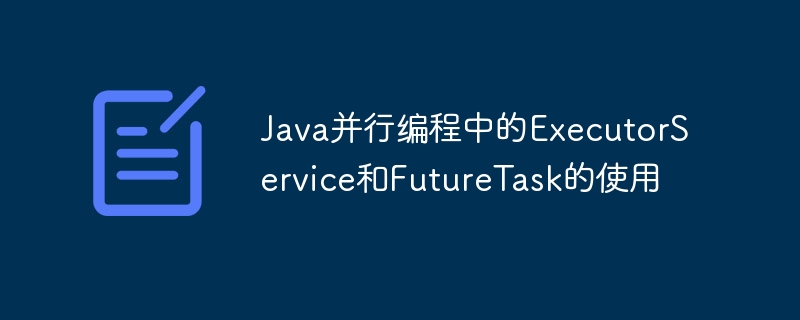The use of ExecutorService and FutureTask in Java parallel programming
Use ExecutorService to manage the thread pool and execute tasks, and use FutureTask to asynchronously execute tasks and retrieve their results. ExecutorService provides methods such as execute() and submit(), and FutureTask provides get(), isDone(), and cancel() methods. Practical examples show how to use them to calculate numbers in the Fibonacci sequence in parallel.

The use of ExecutorService and FutureTask in Java parallel programming
Introduction
ExecutorService and FutureTask are useful tools for parallel programming in Java. ExecutorService allows you to manage a set of threads, while FutureTask allows you to execute tasks asynchronously and retrieve their results.
ExecutorService
ExecutorService is an interface that represents a collection of executable thread tasks. You can create different implementations of ExecutorService using:
ExecutorService executorService = Executors.newFixedThreadPool(5);
where 5 represents the number of threads in the thread pool.
ExecutorService provides the following methods to execute tasks:
execute(Runnable task): Execute a Runnable task.submit(Runnable task): Execute a Runnable task and return a value.submit(Callable<T> task): Execute a Callable task and return a value.
FutureTask
FutureTask is a wrapper around a Callable task that allows you to execute a task asynchronously and retrieve its results later. You can create a FutureTask using the following method:
FutureTask<String> futureTask = new FutureTask<>(() -> "Hello, world!");
where () -> "Hello, world!" is the Callable task to be executed.
FutureTask provides the following methods to retrieve task results:
get(): Blocks waiting for the task to complete and returns the result.isDone(): Check whether the task has been completed.cancel(boolean mayInterruptIfRunning): Cancel the task (if possible).
Practical case
Consider a program that calculates the Fibonacci sequence. We can use ExecutorService and FutureTask to calculate multiple Fibonacci numbers in parallel:
import java.util.concurrent.Callable;
import java.util.concurrent.ExecutorService;
import java.util.concurrent.Executors;
import java.util.concurrent.FutureTask;
class FibonacciTask implements Callable<Long> {
private int n;
public FibonacciTask(int n) {
this.n = n;
}
@Override
public Long call() {
long a = 0;
long b = 1;
for (int i = 0; i < n; i++) {
long temp = a;
a = b;
b = temp + b;
}
return a;
}
}
public class Main {
public static void main(String[] args) {
ExecutorService executorService = Executors.newFixedThreadPool(4);
FutureTask<Long>[] tasks = new FutureTask[10];
// 创建并提交任务
for (int i = 0; i < 10; i++) {
tasks[i] = new FutureTask<>(new FibonacciTask(i));
executorService.submit(tasks[i]);
}
// 获取并打印结果
for (int i = 0; i < 10; i++) {
try {
System.out.println("斐波那契数列第 " + i + " 项:" + tasks[i].get());
} catch (Exception e) {
e.printStackTrace();
}
}
// 关闭 ExecutorService
executorService.shutdown();
}
}In this example, we created an ExecutorService and submitted 10 FibonacciTask tasks. Each task calculates a number in the Fibonacci sequence. Using FutureTask, we are able to execute these tasks asynchronously and get their results later.
The above is the detailed content of The use of ExecutorService and FutureTask in Java parallel programming. For more information, please follow other related articles on the PHP Chinese website!

Hot AI Tools

Undresser.AI Undress
AI-powered app for creating realistic nude photos

AI Clothes Remover
Online AI tool for removing clothes from photos.

Undress AI Tool
Undress images for free

Clothoff.io
AI clothes remover

AI Hentai Generator
Generate AI Hentai for free.

Hot Article

Hot Tools

Notepad++7.3.1
Easy-to-use and free code editor

SublimeText3 Chinese version
Chinese version, very easy to use

Zend Studio 13.0.1
Powerful PHP integrated development environment

Dreamweaver CS6
Visual web development tools

SublimeText3 Mac version
God-level code editing software (SublimeText3)

Hot Topics
 1386
1386
 52
52


